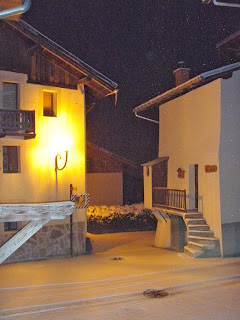A combination of the conditions, New Year week and day visitors from other resorts have resulted in busier than normal Pistes especially after mid morning so we have been taking advantage of the many walks available from our front door. The most demanding is probably the track up to the two Refuges above Les Allues - Le Refuge de la Traie and Le Refuge du Christ. The climb of approximately 1.5 hours is on a well marked, wide track and the reward of reaching the plateau is that you can get lunch, hot drinks, cold drinks (including wine) and if things are really desperate a bed for the night.
The views on the way up to the Refuges are stunning especially on a clear sunny day.
If you have the legs continue past the Refuges for another 20 minutes to the Col de la Lune where you will be rewarded with more open views of the Meribel Valley and then views into the Belleville Valley.
If you are lucky you may spot wildlife whilst walking, we were not lucky this time probably because one of the Village dogs decided to accompany us (uninvited). She spent a lot of time chasing scents here, there and everywhere and an equal amount of time burrowing in the snow no doubt seeking a local wildlife snack of her own. Despite many other walkers she stuck with us, waited patiently while we ate lunch and when we were within sight of Les Allues on the return leg she bounded off no doubt happy that her work as a Mountain Guide was complete for the day.
Dogs who take themselves for a walk is definitely one of the nice things about French Alpine life.






















